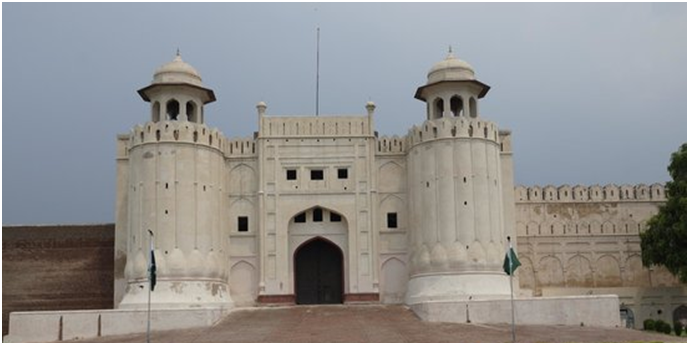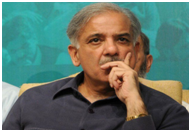


By Fahd Husain

Big brother is winning. Should we be concerned?
There’s something happening in the province of Punjab that is not happening elsewhere: serious
work. But some people fear the galloping disparity between the largest province and the others
will feed into the feeling of alienation — for all the wrong reasons.
As 2016 dawns upon us, there is no doubt that Punjab is years (perhaps even decades) ahead
of other provinces in overall development. Say what you may but Shahbaz Sharif has taken his
province into a different league. Lahore is arguably the most developed city in Pakistan, and the
gap continues to widen.
Yes there’s the usual (and justified criticism) about infrastructure trumping human development
priorities in Punjab, but let’s hold that thought for a bit and look at what’s unfolding in Punjab at
breakneck speed.

Shahbaz Sharif. PHOTO: TARIQ HASAN/EXPRESS
“As I drove from Karachi to Lahore,” says a Karachiite, “and crossed over into Punjab after
Sukkur, it seemed to me like I had entered another country.” The gentleman narrating his impr-
ession anything but a political partisan: “The roads suddenly became better, traffic got more
organised and even the surroundings seemed better.”
Slight exaggeration? Perhaps. But not by much. Compared to Lahore, Karachi is an urban decay.
Potholed roads, cratered highways, unkempt sidewalks, dusty environs, garbage-strewn streets,
clogged drains and a free-for-all traffic mayhem made worse by ineffectual policing.
And then the slight matter of street crime and law and order. And fear. And insecurity. Yes, it’s
better now since the Rangers took charge, but that’s despite the government, not because of it.
The interior of Sindh? Balochistan? Even Khyber-Pakhtunkhwa (K-P) despite some impressive
reforms by the PTI government? Not a patch on Punjab (and especially the central and northern
regions).
Work is getting done. That’s what is happening in Punjab. From impressive infrastructure develop-
ment to public transport systems, modern traffic management and even model-pushcarts that will
have a standardised format and hygiene-checked food — all this and much more is being pushed
through by the provincial government with an eye on 2018. Then there’s the clean drinking water
project, as well as the Punjab IT board that is integrating technology into the arteries of the
government with interesting results. There is a rush to get things done.
Bricks and mortar do define progress in Punjab. This is a progress no other province can match.
But bricks and mortar do not a future make.
The Sharifs’ obsession with highways, bridges and flyovers could end up being their weakness.
Till very recently, their defenders would shrug off this criticism and parrot lines about economy
and foreign investment. But something changed a few months back.
In the Centre and in Punjab, there appears to be a deliberate emphasis on promoting and project-
ing efforts aimed at the social sectors. The prime minister is now often heard talking about the
importance of education, and recently inaugurated new educational projects in the federal capital.
Earlier this week, he also launched the National Health Programme, which aims at providing afford-
able health care to underprivileged citizens. His younger brother, meanwhile, is aggressively
pursuing education and health projects and pushing for reform in these sectors.
Why this new-found focus on the social sector? Could it be the need to change the perception that
the brothers only care about big, visible projects? Could it be the pressure from Imran Khan who
has always prioritised social progress over bricks and mortar? Could it be a genuine desire to fix
the broken health and education sectors? Or perhaps, just perhaps, they have realised that in the
long run what really matters is how educated, empowered and skilled the citizens of a country are.
In any case, the transformation in thinking — or perceived thinking — was long overdue. In Punjab
now, massive amounts of money is being pumped into these sectors. Given the inefficiencies built
into the system, there will be much financial leakage, and many impressive projects will never see
the light of day beyond the files — yet there is relentless pressure on the government machinery to
deliver results. Donor funds are flowing in, along with consultants, experts and advisers.
At a recent meeting, the Punjab chief minister was informed that 110,000 teachers need to be
hired till 2018, which means hiring 37,000 teachers every year to meet the shortage. In addition,
there currently exists a shortage of 60,000 classrooms in the province, and the construction is
being funded by donors. Student retention is a major problem in Punjab (and elsewhere too) even
though official figures claim that student attendance and teacher presence have improved marg-
inally over the last year.
Ask over-eager bureaucrats in Lahore about progress in these areas and they will whip out their
multi-coloured presentations. It is their job to paint rosy pictures and make their boss happy. There
is much in these numbers, graphs and charts that does not bear resemblance to reality on the
ground. The quality of education being taught to children in government schools is pathetic by
acceptable standards. The Sharifs may have finally come around to focusing on the social sectors,
but they left it really late.
But here’s the key: Punjab means business. A donor agency high-up says he has worked extensively
with both the Punjab and K-P governments on education, and he feels both governments genuinely
want to improve the status of education in their respective provinces. “The difference is the man on
top,” he says. “Shahbaz Sharif is the driving force while Pervez Khattak is well-meaning but laidback.”
He says the K-P bureaucracy runs circles around their chief minister while in Punjab it’s the other
way round.
Do the Sharifs skew the system in their favour? Absolutely. Does it help that one brother is the prime
minister? Sure does. Do the beneficiaries of progress in Punjab care about this? Probably not.
But one thing is clear: at this rate, the progress gap between Punjab and the rest of the country will
keep increasing till it may become dangerous. Dangerous? Well, that’s how some people see it. They
fear a highly developed Punjab will cast dark shadows over the federation. The gap would allow in-
competent politicians in other provinces to cry foul, and accuse Punjab of appropriating a dispro-
portionate level of resources at the expense of others.
Nothing could be more unfortunate. Punjab may have taken some undue advantages but Sindh and
Balochistan suffer because of the acute incompetence of their rulers. K-P has done better, yet Punjab
is not to blame for most of its woes. But sadly, perceptions often trump reality, and it may yet turn
out that solid progress in Punjab may in the end be held against it.
How the Brothers Sharif tackle this perceived sense of deprivation will say a lot about their political
skills — and their prospects in 2018.
Published in The Express Tribune, January 3rd, 2016.
Send email to nazeerkahut@punjabics.com with questions, comment or suggestions
Punjabics is a literary, non-profit and non-Political, non-affiliated organization
Punjabics.com @ Copyright 2008 - 2018 Punjabics.Com All Rights Reserved
Website Design & SEO by Webpagetime.com